Who doesn’t feel the urge to get in shape? Even if just now and then. Lucky for us, having a dog along for the jaunt outside encourages us to keep at those fitness goals. Many people enjoy taking their bikes out for a morning or afternoon ride. If you have a dog, a bike ride may seem difficult; how to bring them along? Good thing dog bike trailers exist!
Why Trailers?
If you’re a genuine athlete, you’ve probably seen (and possibly invested in) a hands-free leash for your bike rides. They’re the safest method for taking your dog out on your bike trips. However, those leashes don’t work for every kind of dog. That’s where dog bike trailers come in – even for die-hard athletes.
Dog bike trailers allow EVERY dog to enjoy outings into the world:
- The Scatterbrain: You love your dog, but discipline isn’t their strong suit. Squirrels, flashing lights, and butterflies distract them. Getting jerked around every 5 seconds doesn’t make for a good biking experience (for either of you).
- The “Greyhound”: Sure, Greyhounds are fast – for about a minute. Then they want to sleep for the rest of the day. If your dog can only keep up for half the ride, a dog bike trailer solves the problem.
- The Squishy Face: Pugs and bulldogs love the outdoors. They enjoy the wind in their ears. But keeping up with a bike? That’s not going to happen. But, it doesn’t mean they should get excluded.
- The Bitty Legs: Little dogs have big hearts. And your small breed dog might do their best, but their legs won’t manage. A dog bike trailer is the safest option.
- The Senior: Maybe your dog kept up in their youth. Or perhaps they just had a surgical procedure and have strict orders to take it easy. However, you don’t want to deny your dog the pleasure of their daily bike ride. So they can still join you via the dog bike trailer.
Safety First
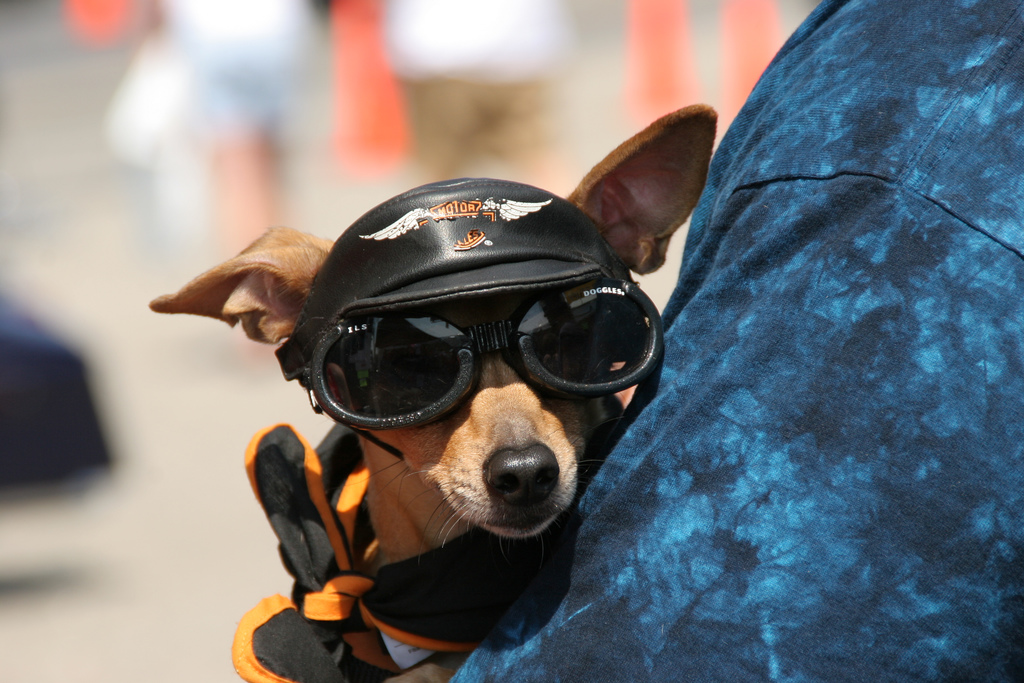
Finding a way to include your dog on bike rides is exciting. They get to experience the world in a new way, even if it’s the same park you walk in. We know dogs savor the feel of the wind through their faces, and dog bike trailers allow that same sensation.
However, dog bike trailers come with important safety reminders. So instead of your usual biking habits, you need to learn some new tricks. Not only to keep your canine companion safe back there but to keep YOU safe, as well.
Rules for the Road
- Your stopping distance INCREASES. The trailer AND your dog add weight to the bike, which means you’re not stopping on a dime. Sudden stops WON’T happen – you’ll end up out of control. Take your time and overestimate the space you need.
- You can’t corner like a Ferrari. (Sorry) Dog bike trailers add width, and you need to take that into account. If you don’t slow down, you AND your dog will tip over.
- Remember that extra weight? It’s going to come as a shock to your body. Even if you’re in great shape, your muscles will protest. So start slow, and keep your first few excursions on the short side. Then, your body will thank you.
- Dog bike trailers aren’t designed for off-road travel. You need to stay on smooth roads and bike trails. Remember, your dog is back there, and they don’t need to get bounced around on rough terrain.
- Safety ALWAYS comes first. As such, make sure you secure your dog with the provided leash restraints. This helps you with balance and keeps your dog from bolting out of the trailer when you open the door.
- Maybe it’s common sense, but this IS the safety section: WEAR YOUR HELMET! Your safety is just as important as your dog’s. You don’t want something to happen to you in an accident. Your brain is kind of important.
Choosing a Dog Bike Trailer

Most dog bike trailers have similar appearances. However, there are a lot of variations in features. So as you look for the trailer that suits your dog’s particular needs the best, make sure you keep the following in mind:
- Installation: Not every dog bike trailer works with every bike. Check the guidelines and make sure it installs on your brand of bike. (Hint: “universal” isn’t always true)
- Screens and Canopies: Dog bike trailers often come with bug screens, overhead canopies, and rain covers. You don’t like swallowing bugs while you bike, so bug screens are handy to have. An overhead canopy protects your dog from excessive sun exposure (make sure you use dog sunscreen). A rain cover’s optional (are you going biking in the rain?).
- Collapsible Frame: You want your trailer to collapse down for easy storage and portability. This helps when you take it with you for a vacation.
- Pneumatic Tires: A pneumatic tire gets filled with air. It’s more comfortable than a solid plastic tire, providing a more cushioning ride. After all, you ride on pneumatic tires yourself.
- Floor Material: Consider your dog’s comfort level. Some dog bike trailers have solid floors, while others have fabric. Solid floors provide more support than fabric, especially over long distances or bumps.
- Leash Attachments: You want the safety of a leash hook or attachment. Remember, you DON’T want your dog to bolt out the door as soon as you open it.
Additional Dog Bike Trailer Safety Features
Dog bike trailers need a few extra safety features. Your chosen trailer may not come with these details. It’s okay – you CAN purchase them separately. However, you want to have them on hand. So again, keep your dog and yourself as safe as possible.
- Reflectors: Your bike comes with reflectors. They increase visibility during low-light conditions. Dog bike trailers need the same reflectors.
- Safety Flags: Flags increase visibility during the day. They’re mounted on poles and extend above the height of the dog bike trailer.
- Parking Brake: The last thing you need is the trailer to move while your dog is getting in or out. Parking brakes keep everything steady. (Make sure you take the brake OFF before trying to pedal anywhere)
- Safety Straps: Dog bike trailers come with a primary hitch. Safety straps are there in case something goes wrong with the hitch. Of course, no one wants that to happen, but you don’t need to worry if you have a backup in place.
Best Dog Bike Trailers
You’re committing to a new fitness program involving a daily bike ride, and you want to bring your dog along. Or maybe you already pedal every day, and you want to incorporate your dog into the routine. Either way, dog bike trailers make that scenic bike ride a touch more fun.
Best Dog Bike Trailer
Dogs WILL get used to dog bike trailers. Take things slowly, allowing them to adjust to the trailer inside the house first. Let them sniff everything and explore the inside with a treat, toy, or even their food bowl. Once they’re comfortable, take the trailer outside for further exploration. And, remember, keep those first trips short. You and your dog need time to adjust. Once comfortable, THEN you guys can take on those longer bike trails.
Bikers around the world recognize the Schwinn name. The Rascal comes in a variety of bright colors to suit any dog. The sturdy steel frame collapses for easy travel and storage, letting you carry your dog bike trailer on trips. The interior leash adjusts in length, and the floor has a non-slip grip to keep your dog safe on the journey. Best of all, you get a one-year limited warranty!
Downsides? Unhappily, there’s a max weight of 50 pounds for this dog bike trailer. Also, if your dog chooses to sit up on the trail (which is fine), you need to slow WAY down on turns, or the trailer pitches over.
The Good
- Steel frame collapses for storage and travel
- Adjustable interior leash
- Non-slip grip on floor
- 1-year limited warranty
The Bad
- Dogs must weight less than 50 pounds
- Need to slow down on turns if dogs sit up
Best Children and Dog Bike Trailers
Okay, it sounds crazy. A children’s trailer? However, several of the bike trailers “intended” for children also work well for dogs. You may not get that interior leash connection, so make sure you find a way to secure your dog safely inside. Children’s trailers are STURDY, and they’re built with safety in mind. As such, you CAN consider them as substitutes for dog bike trailers.
Say you have a larger dog you want to bring along. Allen Sports has the answer. Their trailer can support up to 100 pounds! (Meant to be up to two children, but it’ll work for a large dog) The bottom is padded with extra shock absorption to keep your dog comfortable on the ride. Even better, you get an extra storage compartment in the back for treats, gear, or anything else you may need on a longer excursion. The bike trailer collapses down for storage, too.
Downsides? You’ll need to get a little creative with the harnesses, but it’s manageable. There is no parking brake, so brace the trailer when your dog’s getting in or out. And while you can remove the rain cover, it leaves the back a little more open than is ideal.
The Good
- Dogs can weigh up to 100 pounds
- Bottom padded with extra shock absorption
- Extra storage compartment
The Bad
- Some creativity needed for harnesses
- No parking brake
- When rain cover removed, back stays wide open
Maybe you have two smaller dogs. Or perhaps you have a dog AND a child you’d like to take on your bike outings. The InStep Take 2 solves your dilemma perfectly. The two-seater bike trailer holds two passengers and up to 80 pounds. You get two harnesses for safety, with comfy padding on the bottom, so everyone enjoys the ride. The large mesh windows keep out unwanted insects, while the large opening at the front makes for easy in and out access.
The downsides? In general, people were happy with this dog bike trailer. However, the tires present a couple of problems. Some people found issues when inflating the tires (leaks). Others found the tires failed quickly. And watch the seams in the fabric with heavy use.
The Good
- Dogs can weigh up to 80 pounds
- Can hold 2 passengers
- Large mesh windows
The Bad
- Tires develop leaks
- Seams may develop tears
Want that Schwinn name but need more than 40-50 pounds for your dog? The Joyride fits the bill. This bike trailer can hold up to 92 pounds. Yes, there’s a seat, but it’s cushioned and should keep your dog comfortable on the ride. If you’re uncertain about the footwell, place your gear there for the trip, or even fill it with extra pillows to give your dog more cushioning. You have the harness available for extra safety measures, and your dog’s leash should feed through without a problem.
So what are the downsides? While this dog bike trailer collapses, the wheels don’t. So it’s a little trickier in the storage and portability department. The canopy also restricts the height of your dog. So this works better for medium and smaller dogs than larger dogs (unless you opt to skip the top).
The Good
- Dogs can weigh up to 92 pounds
- Cushioned seat
- Footwell can double as extra storage space
The Bad
- Wheels don't collapse
- Canopy restricts height
Schwinn to the rescue again! The Trailblazer features the same sturdy construction you know you can rely on. You’ll need to provide a soft cushion on the bottom to keep your dog comfortable, but otherwise, it translates well into a dog bike trailer. The entire trailer collapses flat for easy storage or portability. With some creative work, you can even secure your dog’s leash through the included harness.
Downsides? The maximum weight limit on this trailer is 40 pounds. Also, check that your bike will work, as this is NOT a universal fit. And people did find it a little challenging to clean, so make sure to avoid muddy areas.
The Good
- Collapses flat for storage and travel
- Can secure leash through included harness
The Bad
- Dogs must weigh les than 40 pounds
- Not a universal fit for bikes
- Challenging to clean
Best 2-in-1 Dog Bike Trailers
Athletes tend to be flexible. They enjoy a variety of activities. If you split your exercise between running and biking, you might prefer a dog bike trailer that converts into a stroller. That way, your dog can accompany you at all times. Good thing you can find just the thing to accommodate your active lifestyle!
Best Choice Products provides a dog bike trailer that gives comfort and sturdiness to your dog’s ride. Extra-large rear wheels absorb the shock of rough terrains. Want to pamper your dog? You get a removable cushion for the bottom that’ll convince your dog they’re on a royal procession. The mesh windows keep out unwanted flying intruders while still providing adequate ventilation.
Downsides? The weight limit for this dog bike trailer tops out around 66 pounds, though some people felt that ran low. This trailer doesn’t fold flat, so it could be challenging to find somewhere to store it when not in use. Also, some people struggled with assembly, so read your instructions carefully.
The Good
- Extra-large rear wheels absorb shocks from rough terrain
- Removable cushion on bottom
- Mesh windows
The Bad
- Dogs must weigh less than 66 poiunds
- Doesn't fold flat
- Assembly can get tricky
InStep makes a second appearance on this list. While not strictly a dog bike trailer, the Sync 2-in-1 bike trailer works perfectly for small or medium dogs. The steel frame holds up to consistent use, whether as a trailer or stroller. You even get a handy storage compartment to keep your dog’s bowls, treats, or extra needs when you’re out on your run. Finished for the day? The entire trailer folds down flat and stays out of the way.
The downsides? There is a maximum weight limit of 40 pounds for this dog bike trailer. The canopy works great for sunshade, but it won’t retract, which can be a problem for taller dogs. And the same wheel issues surfaced as with the Take 2.
The Good
- Sturdy steel frame
- Handy storage compartment
The Bad
- Dogs must weigh less than 40 poiunds
- Canopy doesn't retract
- Tires develop leaks
Sepnine provides a 2-in-1 option that requires no tools for conversion. Simply add the third wheel, and you’re ready to switch from dog bike trailer to stroller. Your dog gets plenty of room to watch the world through the mesh windows, with a plastic sun cover overhead. You also get all of the safety bells and whistles: an inner leash strap, interior cushion, safety flag, and reflectors. The entire dog trailer collapses flat for portability and simple storage.
So what are the downsides? Again, the maximum weight for this dog bike trailer is 66 pounds. It’s also on the expensive side (though you DO get two options for one). People struggled with turning the front wheel in stroller mode, so be careful with your jogs.
The Good
- Mesh windows and plastic sun cover
- Inner leash strap, safety flag, and reflectors
- Collapses flat for storage and travel
The Bad
- Expensive
- Dogs must weigh less than 66 poiunds
- Difficult to turn the front wheel in stroller mode
Getting in Shape
Everyone feels the need to stretch their legs now and then. When you can include your dog, especially if it wasn’t possible before, it makes the experience richer. Dog bike trailers give any dog the chance to explore biking trails. And if you needed that extra bit of motivation, having your dog along for the ride is often that little push.
So get the bike out of storage, pick out your favorite dog bike trailer, and let’s hit the pavement!

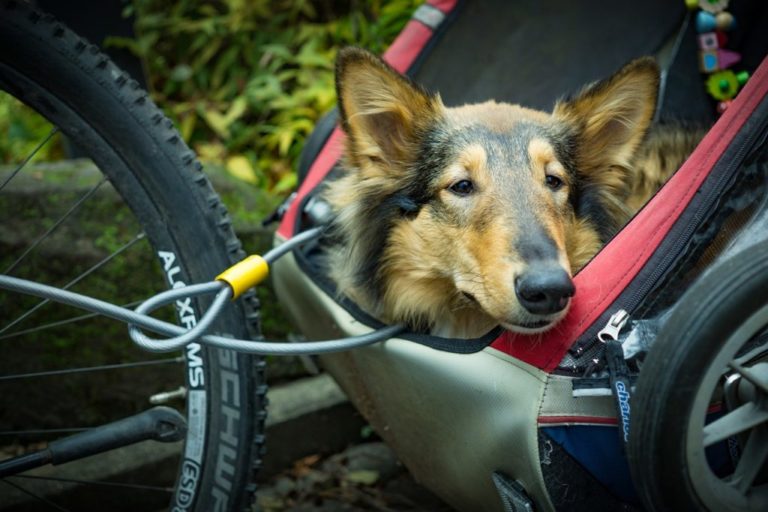
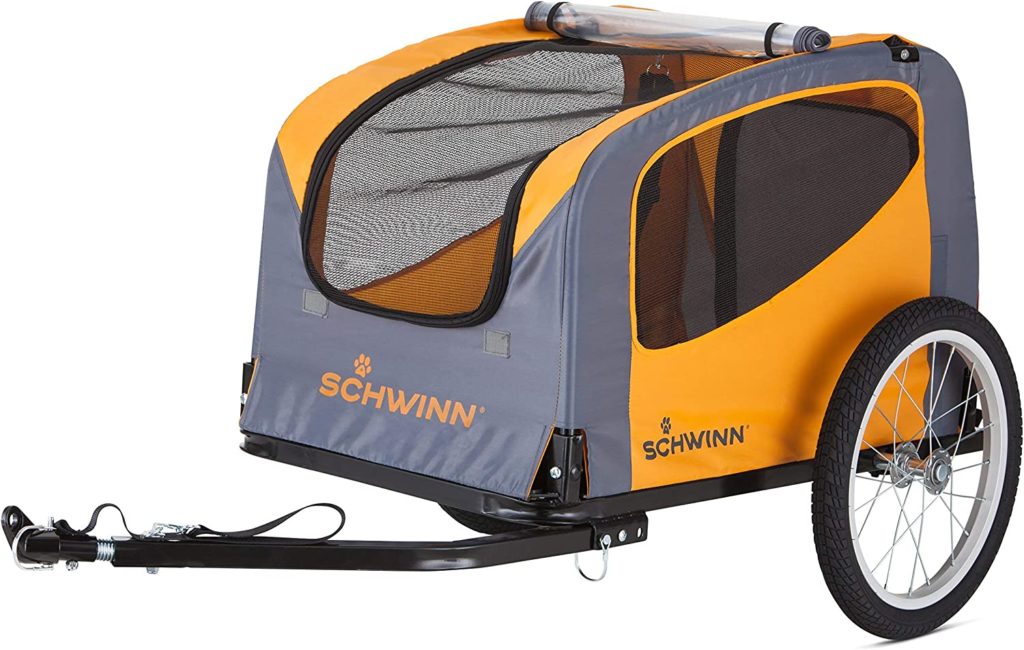
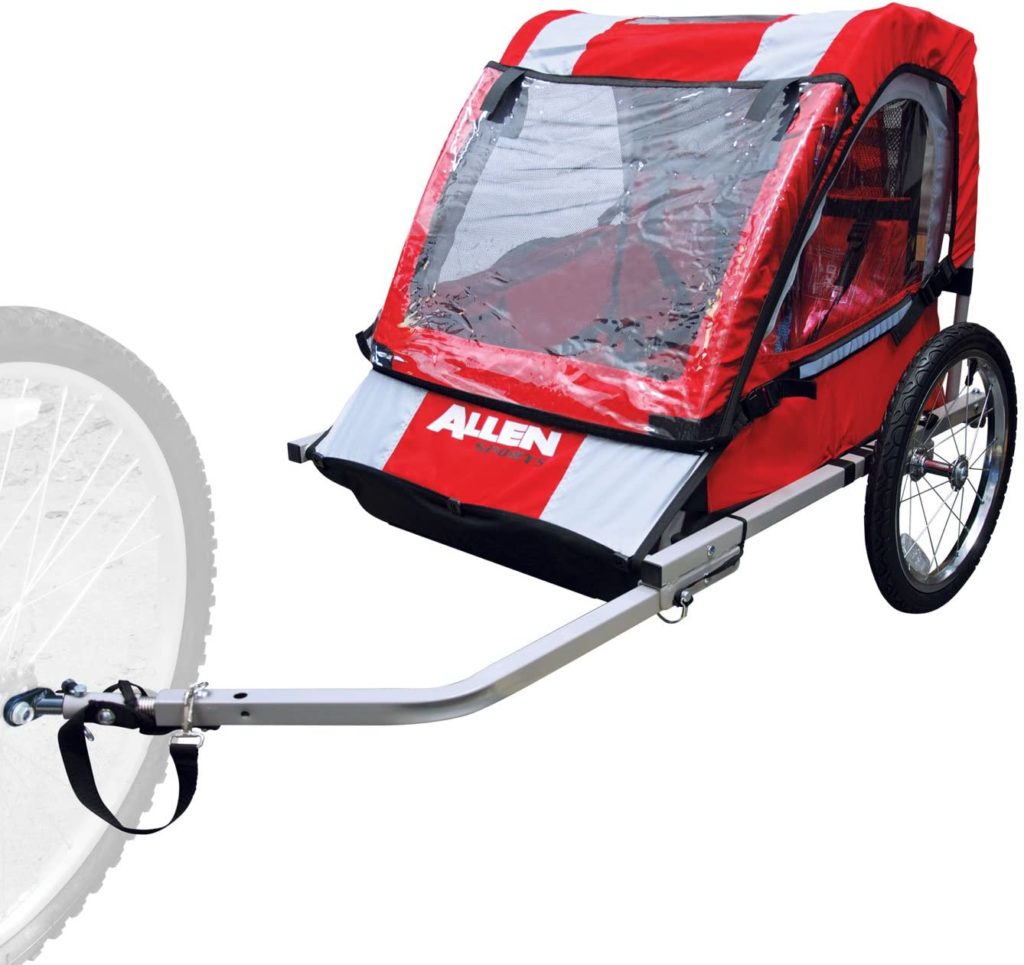
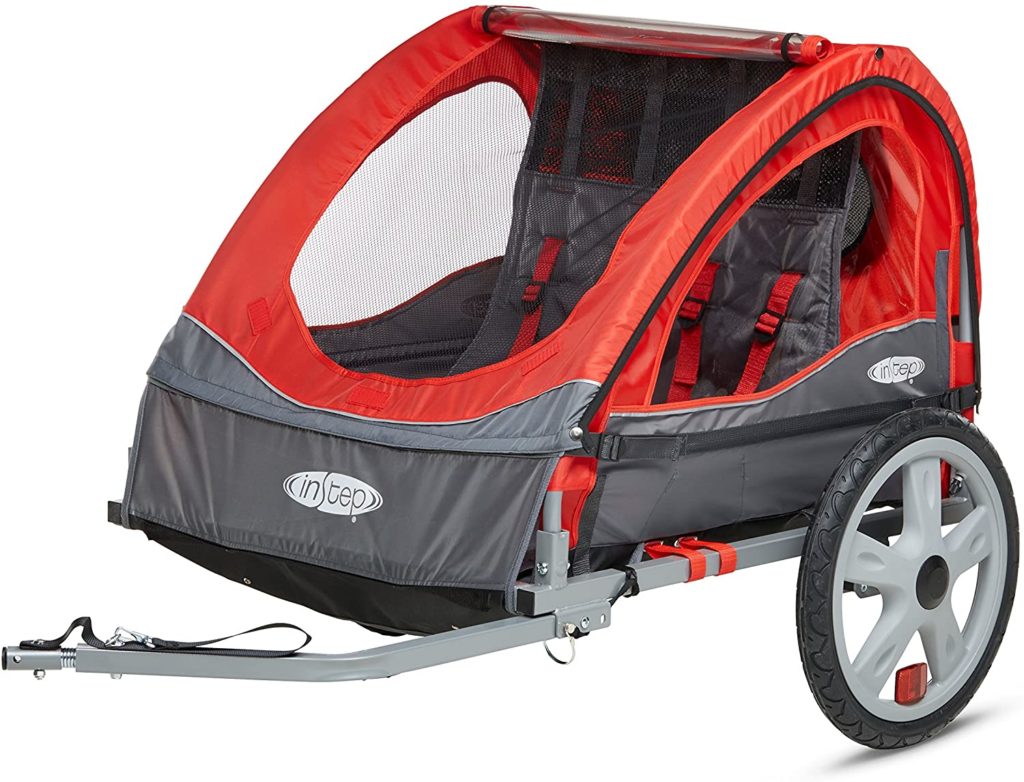
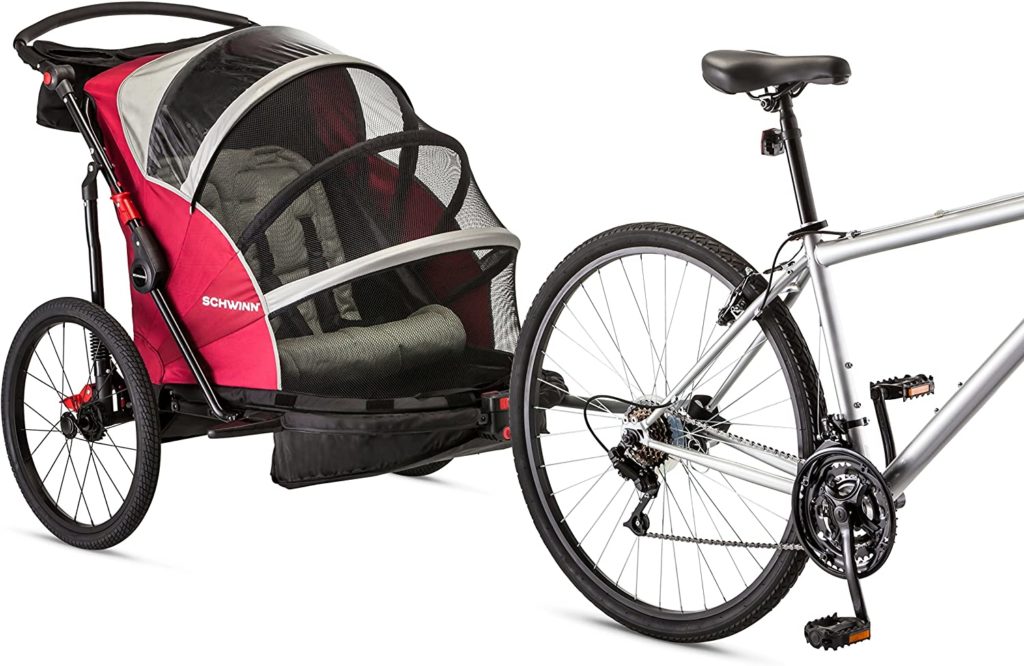
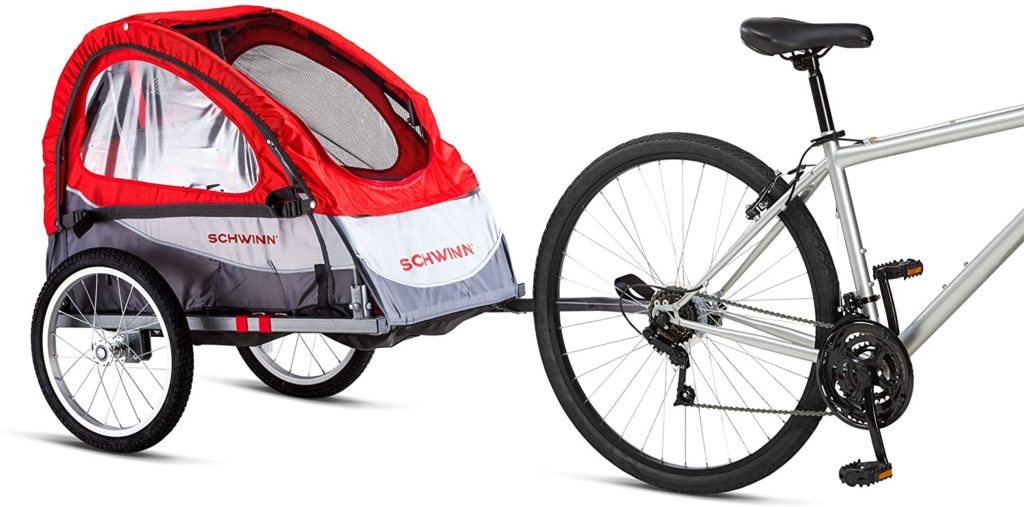
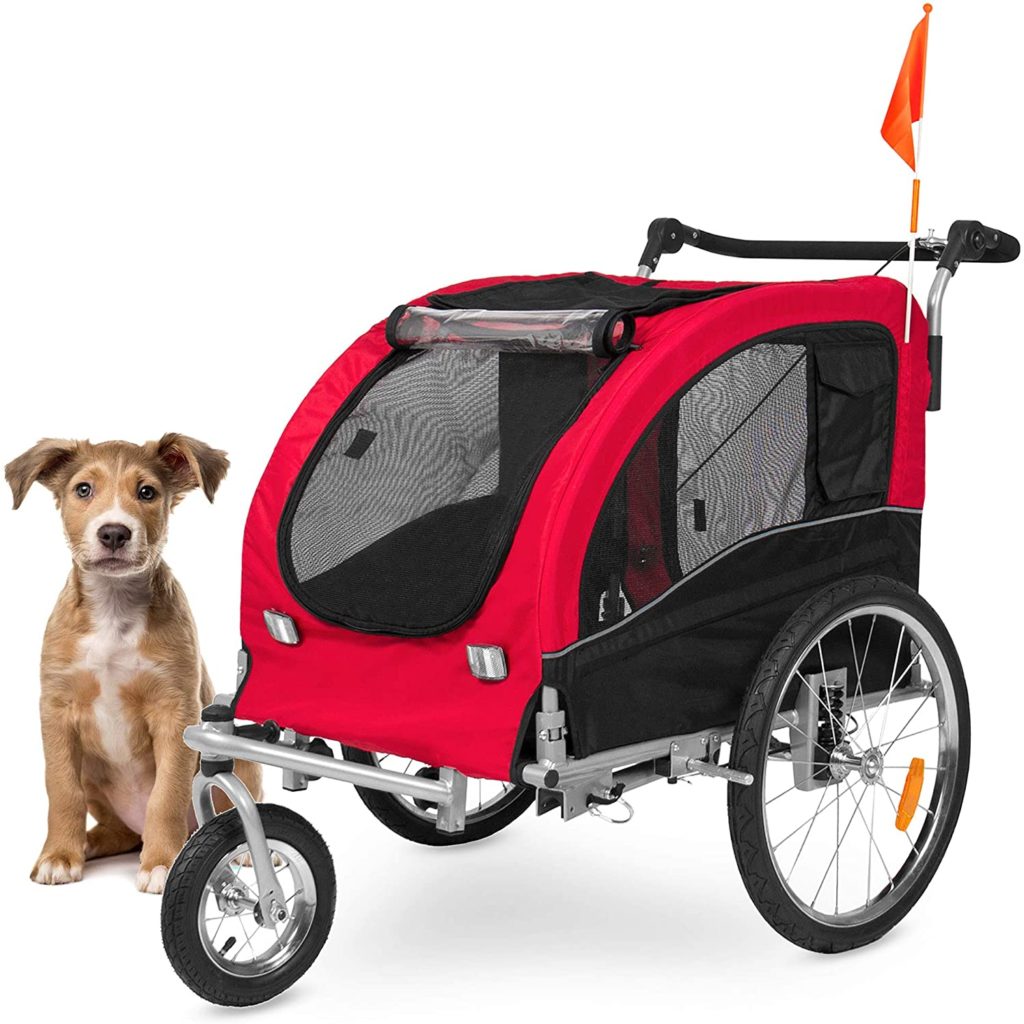
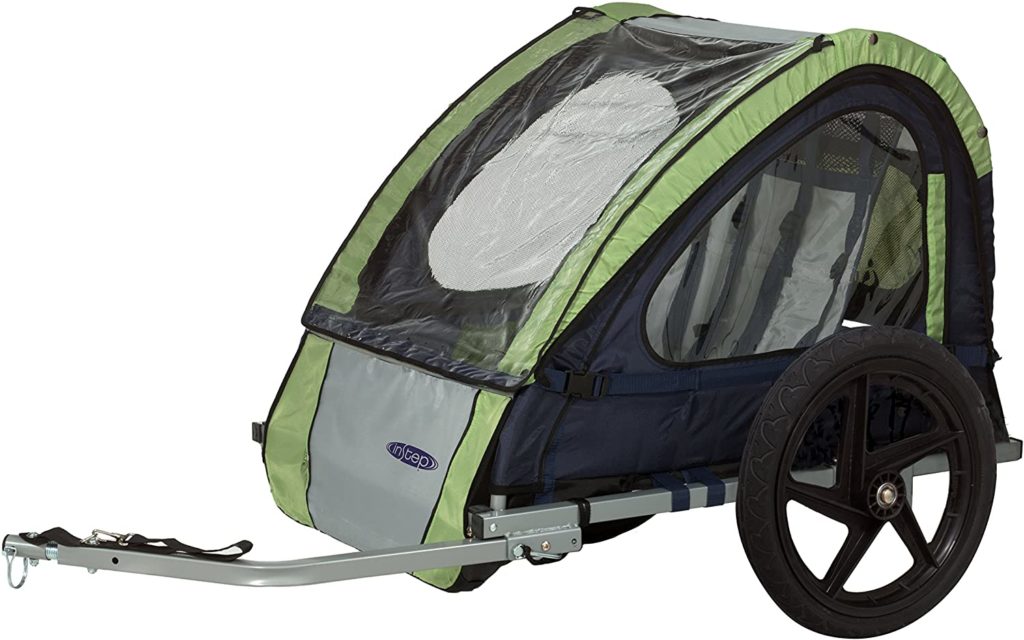
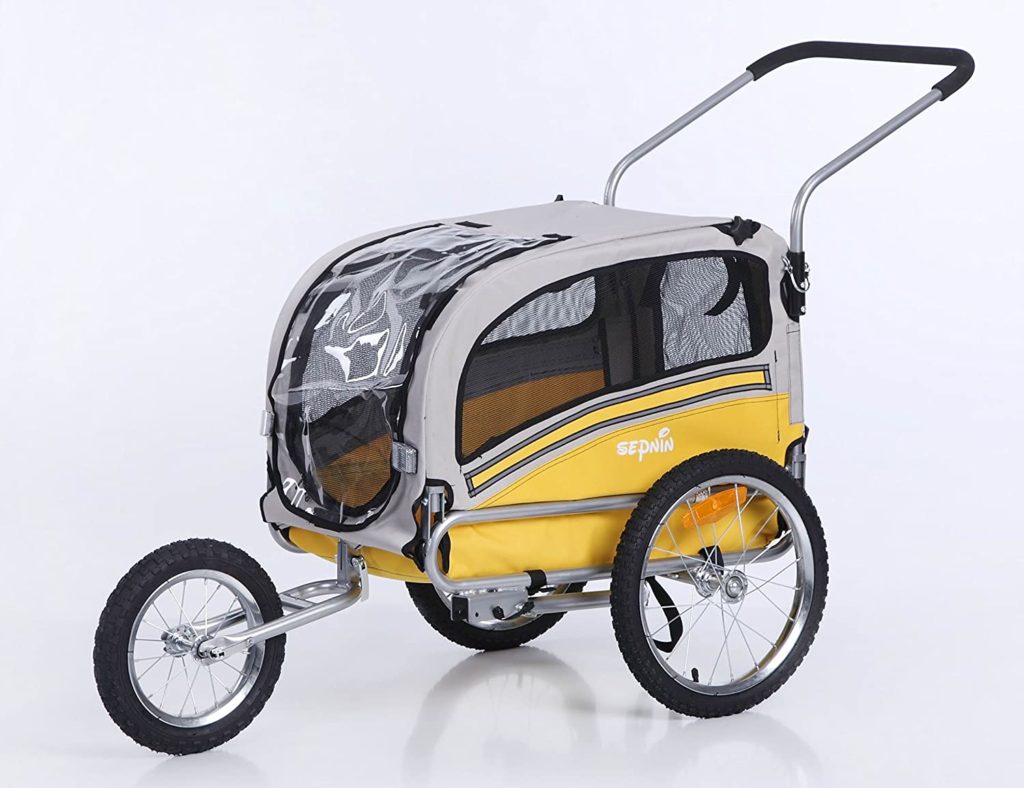




No comment yet, add your voice below!